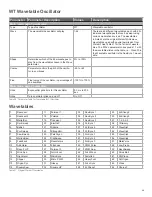
58
Appendix 5-
Sample Specifications
Sample Pools
Solaris loads samples from the CompactFlash card into the RAM on its DSP chips. Solaris has a total of 32MB of sample
RAM. The samples are stored as mono 16 bit signed headerless (‘raw’) audio files on the CompactFlash card. .Wav files
will work as well. The current OS version looks for a folder named ‘Samples’ to find the samples. A sample pool consists of
audio sample files and a text file defining how to load and play them. The definition of a sample pool is done with a simple
text file in the same folder (use a naming like ‘SamplePool-001.txt’, ‘SamplePool-002.txt’, etc.).
[Pool]
name = Glockenspiel
[Sample]
sampleindex = 1
filename = Glockenspiel B3.raw
samplerate = 44100
samplelength = 43753
loopstart = 43042
loopend = 43753
rootkey = 59
finetune = 0
lowkey = 0
highkey = 127
[Sample]
sampleindex = 2
filename = Glockenspiel B5.raw
samplerate = 44100
samplelength = 40628
loopstart = 39628
loopend = 40628
rootkey = 83
finetune = 0
lowkey = 0
highkey = 127
Figure 90.
Example SamplePool text file
The sample pool file shown in Figure 90 contains two individual samples. These two samples will show up as samples 1
and 2 in the
Wave
parameter of any oscillator slot running a sample playback (Wav) oscillator type. It is possible to cre-
ate multi-samples for use with Solaris, by editing the
lowkey
and
highkey
values of each sample, to indicate over which
MIDI note range they should each play.
Each new note will play the sample currently selected by the active oscillator(s). You could play and hold
sample 1 from the example above (using the sustain pedal or
Hold
button), change the oscillator’s
Wave
parameter to the second sample, and press another key. The new note-on event will cause the oscillator
to play the second sample, even though the first sample may still be playing.
Summary of Contents for Solaris
Page 1: ...User Guide Version 1 ...









































